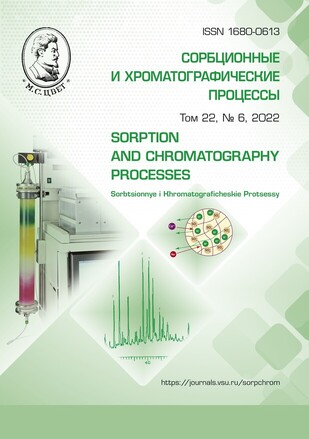Analysis of an amino acid composition and the structure of amaranth protein isolates under different conditions of protein isola-tion
Abstract
This work is devoted to the study of amaranth proteins (Amaranthus hypochondriacus L.) as a promising crop for obtaining a comprehensive plant protein. It determines the conditions for the maximum protein yield from amaranth seed flour during alkaline extraction and precipitation at different pH values. The study involved determining molecular masses, amino acid composition, and functional groups of protein isolates. The albumin, globulin, prolamin, and glutelin content in the protein were 3.5, 3.7, 0.8, and 5.7 g per 100 g of amaranth seed flour, respectively. It was shown that sequential extraction of protein with water and 0.1 M NaCl solution at the extraction pH of 12.0 with its further precipitation from the extract at the pH of 4.0 allows achieving the maximum protein yield from defatted amaranth flour and obtaining a protein isolate with a protein mass fraction of 90%. The protein yields were 53.77% and 20.52% for water and salt extraction, respectively. It was established that obtained isolates had proteins with molecular masses of less than 15.4 kDa, 18-20 kDa, 20-36 kDa, and 36-38 kDa, 41-45 kDa, and 54 kDa, which are characteristic of albumins, globulins (7S- and 11S-globulinm) and glutelins. The content of prolamins in the protein isolate was excluded due to their hydrophobicity. The method of capillary electrophoresis determined that the main amino acids of the amaranth seed protein were arginine, lysine, aspartic acid, glutamic acid, proline, and leucine. Amaranth protein isolates had reduced amounts of methionine and cysteine by 95 and 86%, respectively, per 100 g of product and increased amounts of the remaining amino acids. Fourier IR spectroscopy was used to find out that protein isolates had expressed fluctuations of methyl and methylene groups, which was accompanied by a decrease in the solubility of the obtained samples. These data do not reduce the biological value of the protein and can be used for the further study of the functional and technological properties of the plant protein for its practical application.
Downloads
References
Kudinov P.I., Shchekoldina T.V., Slizkaya A.S., Current state and structure of world resources of vegetable protein. Izvestiya vuzov. Food technology. 2012; 4: 124-130. (In Russ.)
Kompantsev D.V., Popov I.M., Privalov E.F., Stepanova A.V. Protein isolates from vegetable raw materials: a re-view of the current state and analysis of the prospects for the development of technology for obtaining protein isolates from vegetable raw materials, Modern problems of science and education. 2016; 1. https://www.science-education.ru/ru/article/view?id=24132.
Ferreira T.A., Gómez-Áreas J.A., Calcium bioavailability of raw and extruded amaranth grains. Cienc. Tecnol. Ali-ment. 2010; 30; 532-538. https://doi.org/10.1590/S0101-20612010000200037
Repo-Carrasco-Valencia R., Hell-strom J.K., Pihlava J.M., Mattila P.H., Flavonoids and other phenolic compounds in andean indigenous grains: Quinoa (Cheno-podium quinoa), kaniwa (Chenopodiumpallidicaule) and kiwicha (Amaranthuscaudatus). Food Chem. 2010; 120 (1): 128-133. https://doi.org/10.1016/j.foodchem.2009.09.087
Aguilar E.G., Peiretti E.G., Uñates M.A., Marchevsky E.J., Escudero N.L., Camiña J.M. Amaranth seed varieties: A chemometric approach. Food Measure. 2013; 7: 199-206. https://doi.org/10.1007/s11694-013-9156-1
Shmalko N.A., Roslyakov Yu.F. Amaranth in the food industry. Krasnodar: Enlightenment-South, 2011. 400 p.
Grobelnik-Mlakar S., Turinek M., Jakop M., Bavec M., Bavec F. Nutrition value and use of grain amaranth: potential future application in bread making. Agricultura. 2009; 6: 43-53.
Awasthi C.P., Kumar A., Singh N., Thakur R. Biochemical composition of grain amaranth genotypes of himachalpradesh. Indian. J. Agric. Biochem. 2011; 24: 141-144.
Aceituno-Medina M., Lopez-Rubio A., Mendoza S., Lagaron J.M. Develop-ment of novel ultrathin structures based in amaranth (Amaranthushypochondriacus) protein isolate through electrospinning. Food Hydrocolloids. 2013; 31(2): 289-298.
Lado M.B., Burini J., Rinaldi G., Añón M.C., Tironi V.A., Effects of the Die-tary Addition of Amaranth (Amaranthus-mantegazzianus). Protein Isolate on Anti-oxidant Status, Lipid Profiles and Blood Pressure of Rats. Plant Food Hum. Nutr. 2015; 70 (4); 371-379.
Stepanov K.V., Pirogov A.V., Dikunets M.A., Shpigun O.A. Obtaining amino acid phenylthiohydantoins for quantitative analysis of the amino acid composition of proteins by capillary electrophoresis. Mess. Moscow University. Ser. 2. Chemistry. 2005; 46(6): 395-399. (In Russ.)
Srivastava R, Roy B. Proteomic analysis of different extracts from amaranth (Amaranthus tricolor) grains. Asian J Pharm Clin Res. 2013; 6: 37-39.
Derkanosova N.M., Stakhurlova A.A., Pshenichnaya I.A., Ponomareva I.N., Peregonchaya O.V., Sokolova S.A. Amaranth as a bread enriching ingredient. Foods and Raw Materials. 2020; 8(2): 223-231.







